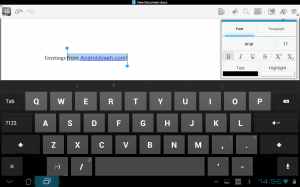 Google has launched its Microsoft Office substitute, Quickoffice, for the iPhone, Android smartphones and Android tablets, fulfilling a promise made in December.
Google has launched its Microsoft Office substitute, Quickoffice, for the iPhone, Android smartphones and Android tablets, fulfilling a promise made in December.
The release on Tuesday follows the launch of Quickoffice for Apple’s iPad late last year, when a Google executive said that iPhone and Android versions “are on the way.” The move was also preceded by a February announcement that Google was baking the Quickoffice technology into both its Chrome browser and Chrome OS.
Quickoffice for the iPhone lets Google Apps for Business customers view, edit and create Word, PowerPoint and Excel documents.
The search giant acquired Quickoffice in mid-2012 and rolled the firm’s development team into its Google Apps group. On the iPhone, iPad and Android smartphones and tablets, Quickoffice lets customers view, create and edit Word, Excel and PowerPoint documents.
The new iOS and Android apps are available free to paying customers of Google Apps for Business, a cloud-based suite that costs $50 per user for a one-year subscription.
Customers that don’t subscribe to Google Apps can buy stand-alone apps – Quickoffice Pro for iPhones and Android smartphones, Quickoffice Pro HD for iPads and Android tablets – for $15 and $20, respectively.
Google also boasted that the new apps, as well as the December iPad app, which was updated Tuesday, are now more tightly tied to Google Drive, the search company’s online storage service.
Quickoffice for iOS – the same app runs on both the iPhone and iPad – can be downloaded free of charge from Apple’s App Store; the Android version is available on Google Play. Neither will work without a Google Apps for Business account.
Microsoft, long rumoured to be considering porting all or some of its Office suite to iOS, perhaps Android as well, has remained mum on its plans. Most experts believe that, assuming Microsoft pulls the trigger, it will take the same approach as Google to sidestep Apple’s 30 percent cut of all App Store revenue: Offer the Office apps free of charge, but enable them only for customers with an Office 365 subscription.
Analysts are convinced that Microsoft will eventually release Office for iOS and Android, with some of the more bullish estimating that the Redmond, Washington, developer could generate billions from app sales.
Others, however, have worried that Microsoft’s window of opportunity is relatively small because of a rapid shift to smaller, 7-in. and 8-in. tablets, which are substandard platforms for creating content, and that it must act soon.





